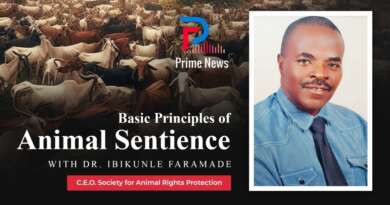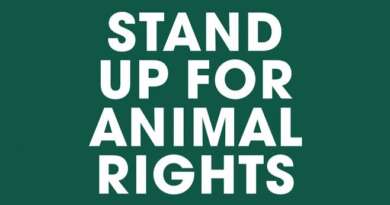Welfare Considerations During Transportation of Animals 1
By Dr Ibikunle Faramade
In general, animals could be categorized into two broad categories, i.e., domestic animals and wild animals. Domestic animals have undergone domestication by man over a very long time in order to make use of them for different purposes. Domestic animals include companion animals such as dog, cat, and horses. It also include food animals such as cattle, sheep, goat, pigs and different types of poultry. In addition, there are beasts of burden (special purpose biological ‘vehicle’) for transportation, e.g. donkey, mule and camels (camels are described as the ship of the desert). Apart from this distinct categories of animals, we have another category which could be selected from any of the named categories, called pet animals. Any animal could be made a pet, whether it is companion, food animal, beast of burden or poultry. In some instances, in certain parts of the world, some wildlife species could be treated as pets. It is however noteworthy that members of companion animals are mostly considered as pets globally. Wild animals, also called wildlife are animals who are untamed and whose survival is independent of man. They are dwellers of the natural habitats (terrestrial, arboreal, aquatic). However, they also serve as food for man through hunting. In addition, wildlife serves as rich source of education and entertainment (when kept in zoological garden) or through tourism (when they are visited in their natural habitats)
Humans have reasons to move these animals from one place to the other for many reasons. Chief among the reasons is the transportation of animals from where they are bred/ produced to the market. All animals are moved from time to time irrespective of their categories, although, food animals (livestock) and poultry as previously stated are the most frequently transported in large numbers between farms and markets and across international boundaries. Companion animals are transported for trade purposes within the country and across international borders (dogs and cats are imported and exported routinely). Exotic birds and wildlife could also be transported from one place to another etc. in essence, animal transportation is a necessity.
Considering the fact that animal transportation is a necessity, as they contribute significantly to human survival in terms of nutritional, material and enormous economic benefits nationally, regionally, and internationally among others, how do we transport them in the context of good welfare considerations? How do we operate within the context of recommended five levels of animal freedom as documented by Brambell Committee on farm animal welfare in 1965, i.e., Freedom from thirst, hunger and malnutrition (by ready access to fresh water and diet to maintain full health and vigor), Freedom from discomfort (by providing a suitable environment including shelter and a comfortable rest area), Freedom to express normal behavior ( by providing sufficient space, proper facilities and company of the animal’s own kind), Freedom from pain, injury and disease (by prevention or rapid diagnosis and treatment), Freedom from fear and distress by ensuring conditions which avoid mental suffering?
The first important step is our (conscious) acceptance and recognition of animals as sentient beings. That is, their recognition as living creatures with developed nervous system and ‘cognitive’ ability that makes them capable of feeling hunger, thirst, pain, distress etc. Animals could also have emotional feelings (of sadness and happiness), they also have their unique reproductive behaviors among others. The understanding of this will guide us to know how we should handle them during transportation. There are different recommended transport requirements for different types of animals with respect to the species, age, size sex and physiological state.
Food Animal Transportation (Cattle, Sheep, Goat, Pigs)
In Nigeria, cattle, sheep and goat are the most important animal transported across international borders and within the country. Some of the cattle consumed in Nigeria are transported as far away as from Mali, Senegal, Burkina Faso, Cameroon, The Gambia and Mauritania. They are transported by means of articulated vehicles for several days from the point of loading to the point of offloading. It has been established that these animals are subjected to diverse kind of harsh conditions with attendant negative welfare consequences. These include group stress, handling stress, heat stress, injuries, motion stress, prolonged hunger, prolonged thirst, respiratory diseases, restriction of movement problems and sensory overstimulation.
Group stress is caused by fear and frustration due to incidence of aggression and other negative social interactions as the animals grapple with hierarchy formation and competition for resources and mates. Handling stress is due to manual or mechanical handling, beating and forced movement during loading of animals into the articulated vehicles. Heat stress occur as a result of overcrowding and exposure to sun rays throughout the long journey. They suffer scalding (burning heat) as a result of exposure to hot metal plates when they lean on the metal plates/walls of the truck. Injuries occur concomitantly as the animals are forcefully moved or when aggressive ones attack feeble ones in the same vehicle. Motion stress occur as a result of effect of motion on animals during transportation. It causes nausea, vomiting, drowsiness etc. Prolonged hunger and thirst occur as a result of long days of journey before arriving at their destinations without adequate provision of feed and water. Animals are exposed to respiratory distress because of exposure to cold air in the night (high velocity) and hot air with dust during the day predisposing them to cough and catarrh. Lack of resting opportunity and prolong restriction of movement expose the animals to fatigue, lameness, recumbence and death.




To be continued……..
Dr. Ibikunle Faramade is a veterinary pathologist and a lecturer at the Federal College of Animal Health & Production Technology, Apata. Ibadan. He’s the C.E.O of the Society for Animal Rights Protection, a non-profit and a non-governmental organization dedicated to the promotion of animal welfare, animal rights and prevention of cruelty to animals.
animalrightsprotection2020@gmail.com , +2348028305284




